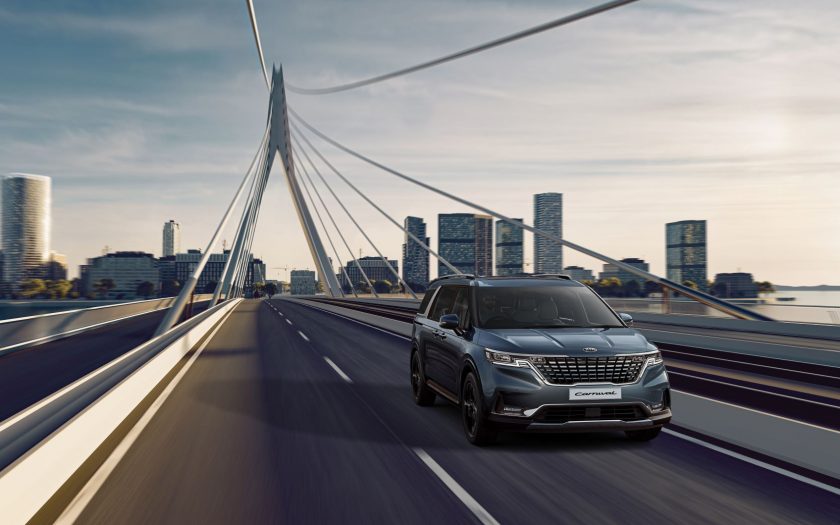THE BLURRING OF CATEGORIES continues with Kia’s new fourth-gen Carnival. Already far and away Australia’s most popular people mover, now Kia is moving to capture a fair chunk of the large SUV category with the latest model.
“The Kia Carnival has always provided practicality, comfort, space and power, which has seen it consistently hold an unchallenged segment share of up to 51 percent.” Kia Motors Australia Chief Operating Officer Damien Meredith said.
“The all-new Carnival still provides these essentials but adds on class leading features, with an outstanding design and driving features similar to a SUV. The appeal has increased; possibly to shoppers looking at the Upper Large SUV under-$100,000 segment.”
We’d have to agree.
The new Carnival wouldn’t be embarrassed standing next to any of the upper large SUVs, and since most buyers don’t need all-wheel drive, the front-wheel-drive-only specification shouldn’t dissuade many buyers. And at the price, it’s a positive bargain.
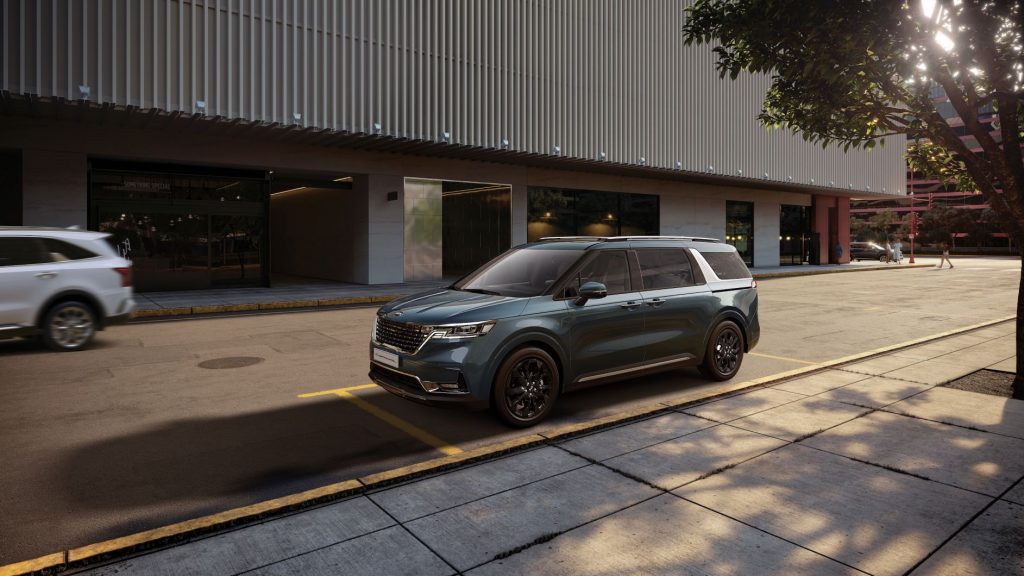
Platform shared with new Sorento
Appearances to the contrary, the new Carnival sits on the same mid-size platform as Kia’s Sorento SUV.
For Australian buyers the fourth-generation Carnival will be available in four specification levels, S, Si, SLi and Platinum, in both petrol and diesel engines. Both the Smartstream 3.5-litre GDI V6 petrol (216kW and 355Nm) and Smartstream R2.2-litre CRDI diesel (148kW and 440Nm) drive the front wheels through a Kia-developed 8-speed automatic.
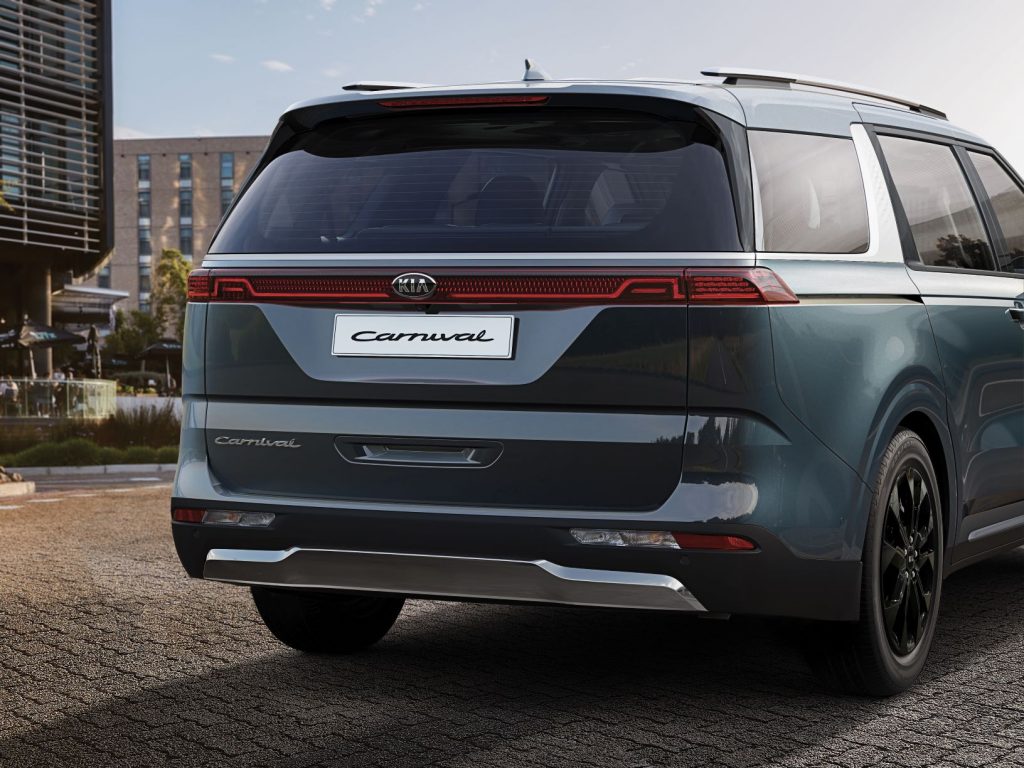
Impressively equipped, even at entry level
The entry-level S specification comes standard with 17-inch alloy wheels, roof rack, solar glass windshield, 8-inch AV unit with wireless Android Auto and Apple CarPlay, 4.2-inch TFT LCD cluster, 6-speaker sound system, manual temperature control, drive mode select with normal/eco/sport/smart, keyless entry, cloth seats, rear parking sensors, rear view monitor with dynamic guidelines, tilt and telescopic adjustable steering wheel and a full safety suite including class-first technology (see separate safety section).
In addition, the Si adds 18-inch alloys, 12.3-inch AVN unit, 8-speaker sound system, dual zone automatic temperature control front and single zone rear, premium steering wheel and shifting knob, and front parking sensors.
Stepping up to the SLi brings privacy rear glass, smart key with push button start, artificial leather seats, surround view monitor, power tailgate with auto close, smart power sliding doors, one-touch power doors and tailgate, eight-way power driver’s seat, auto up/down windows, electrochromic mirror, Safe Exit Alert and Rear Cross Traffic Collision Avoidance Assist.
At the top of the range the Platinum leaves little to be desired, adding electronic shift by wire, 19-inch black alloy wheels, 12-speaker Bose sound system, rear occupant alert, heated steering wheel, wireless charger, paddle shifters, dual tilting and sliding sunroof, eight-way integrated memory seats with 4-way lumbar support and rear heated seats, ventilated front seats, LED interior lamps and second and third row sunshade blind.
Pricing (all plus on road costs, but driveaway prices are listed below) will start at $46,880 for the S petrol and rise to $64,680 for the Platinum version of the same engine. The diesel starts at $48,880 for the S trim and tops out at $66,680 for the Platinum. Premium paint is a $695 option.
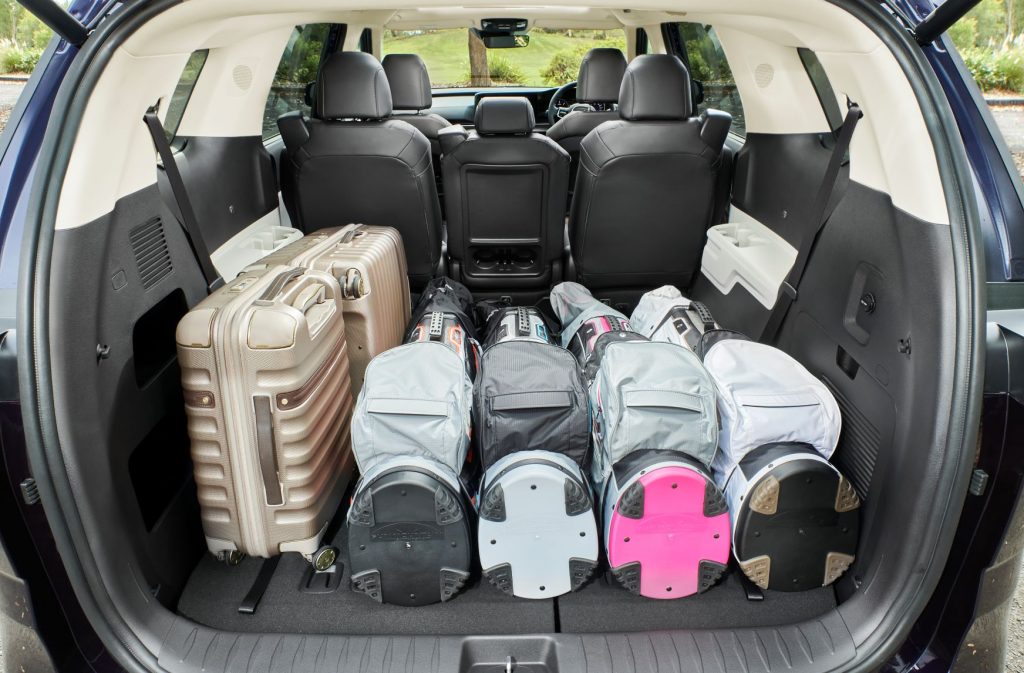
Tauter design
Compared to the previous Carnival, the new one has a shorter front overhang, and the A-pillar has been moved back to create a longer hood (a design change that more effectively disguises the people mover characteristics).
The increased wheelbase creates even more space inside a cabin that was already generous in the outgoing model.
The profile is closer to an SUV (Kia calls the Carnival a “GUV” – grand utility vehicle). From various perspectives, hints of the Sorento can be seen. A key design feature is the island roof with blacked-out A- and B-pillars. The C-pillar design is also distinctive with its chrome fin wearing a subtle diamond pattern.
At the rear, in keeping with the people mover design, the tailgate is more upright.
The Cd (co-efficient of friction) is a remarkable 0.32. To put that into perspective, the sleek-looking Ferrari 612 Scaglietti (2004-2011) could only manage 0.34Cd after 3500 hours of refinement in the wind tunnel.
For the S, Si and SLi models, the headlamps are LED for high and low beam with a bulb-type turning signal lamp. The Platinum model adds projection-style low and high beam lamps with an LED turn signal.
Other SUV-like features are the lower air intake at the front, matched with metallic trim and a black lower bumper, and the metallic lower skid plate.
A clever touch is the rear wiper that tucks away under the rear spoiler when not in use.
The new Carnival offers customers a choice of seven exterior paint colours; Ceramic Silver, Astra Blue, Silky Silver, Deep Chroma Blue, Panthera Metal, Snow White Pearl and Aurora Black Pearl. All colours are metallic or mica-metallic, with Ceramic Silver designated as the “standard” colour at no additional charge, meaning you’ll have to add $695 to the price of any Carnival that isn’t Ceramic Silver.
Dependent on specification level, there is a range of distinctive aluminium alloy wheel designs, 17-inch (S), 18-inch (Si and SLi) or 19-inch (Platinum). Disappointingly, all come with a temporary (space saver) spare wheel.
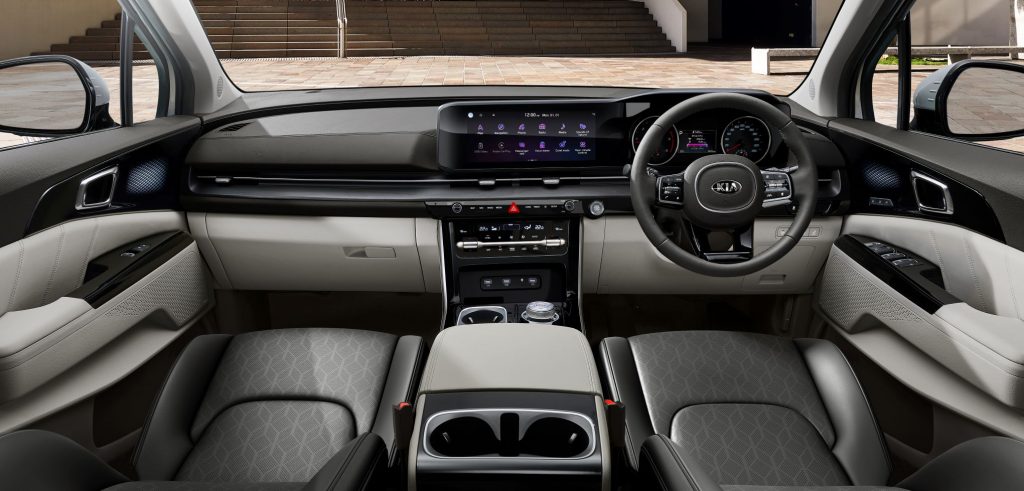
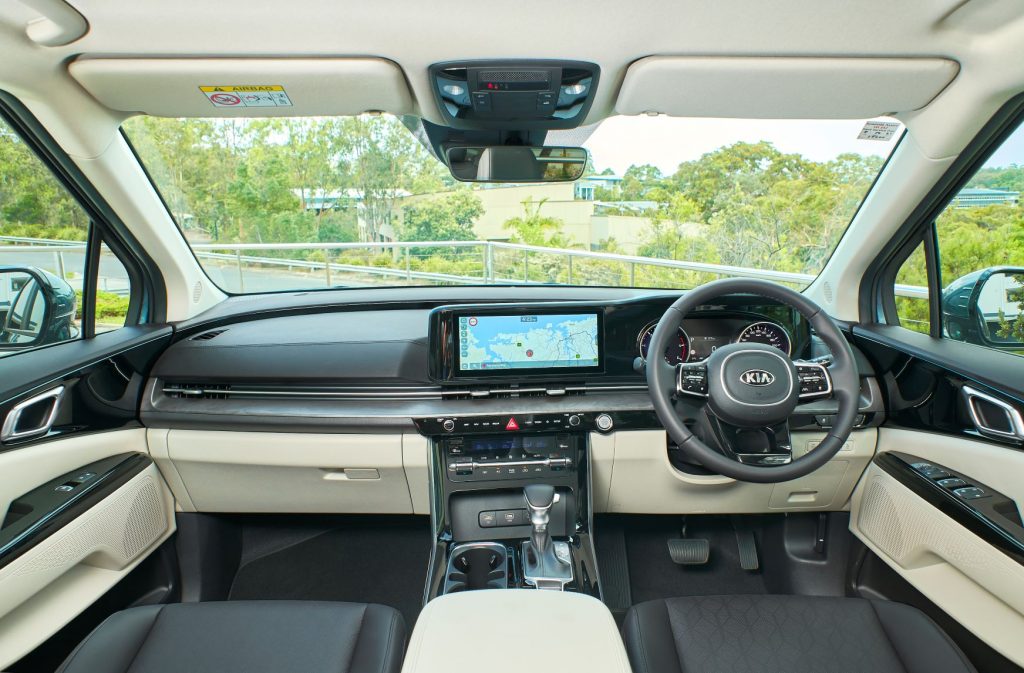
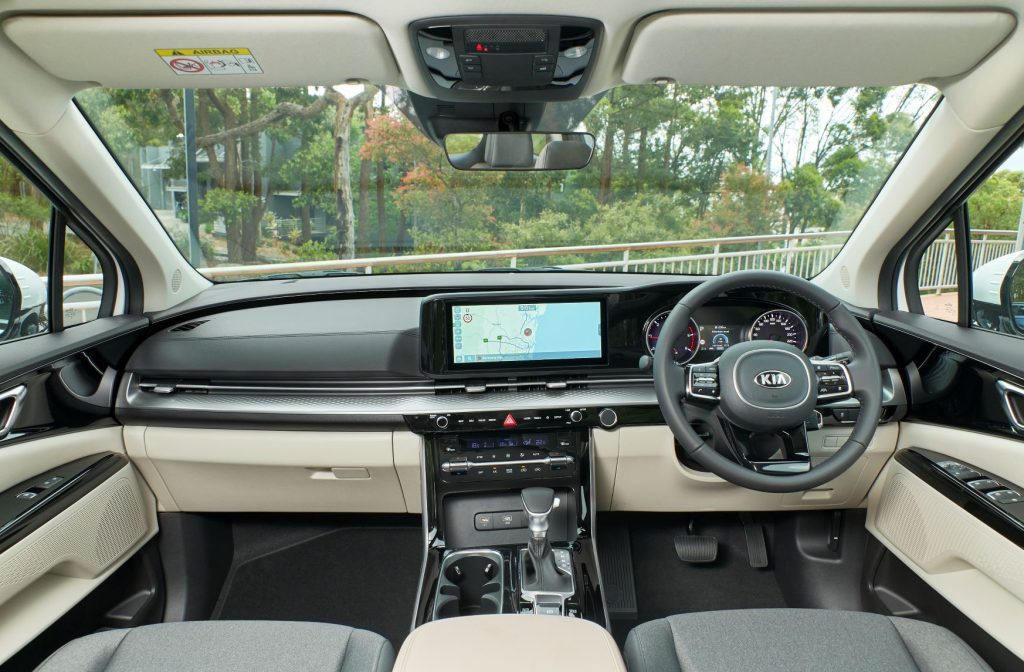
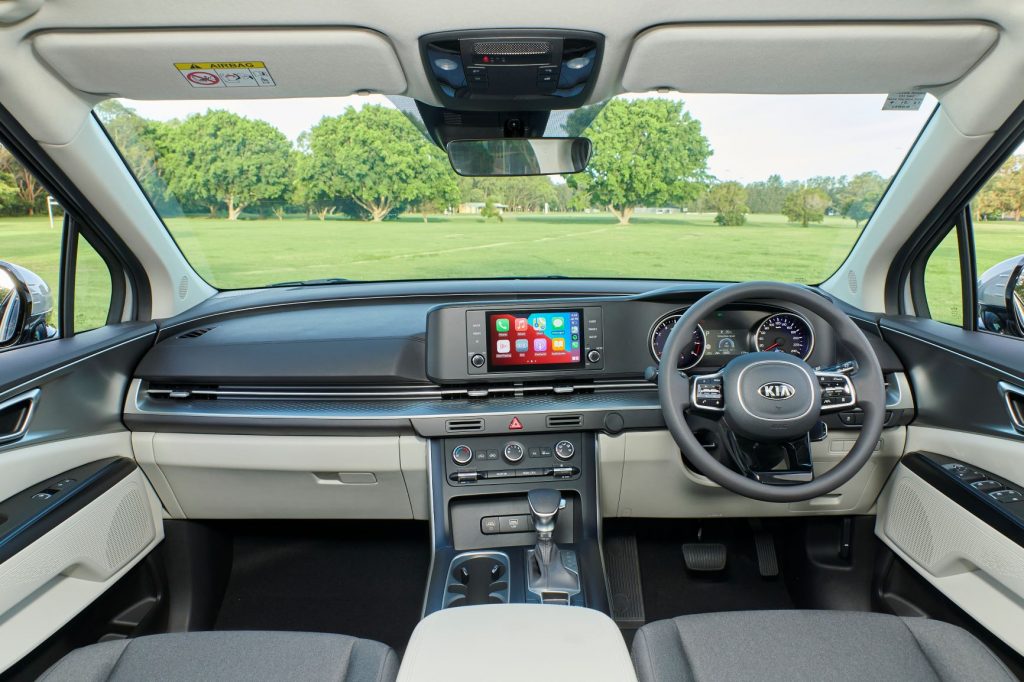
Classy interior design and trim
As has been happening with Kia models across the range, the interior is a step up from the previous model, both in design and quality.
The high-tech approach is most obvious in the wide, panoramic-screen dashboard design. Also notable is the unobtrusive shift-by-wire dial for the transmission located at the base of the centre console.
A favourite feature (Platinum model only) is heated/ventilated front seats that operate automatically when a sensor detects the need.
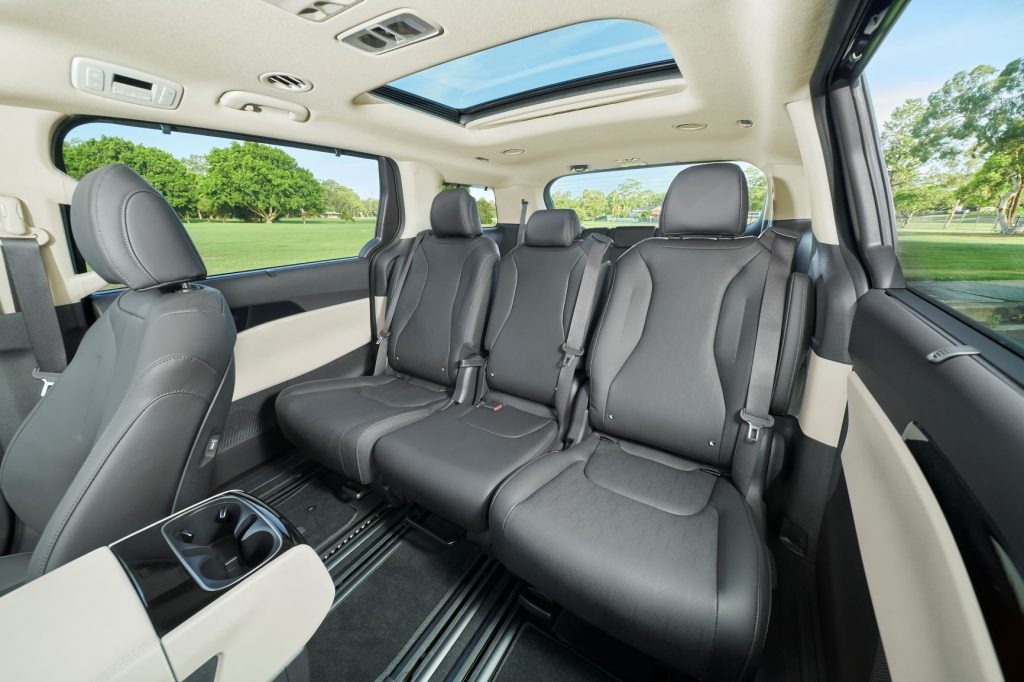
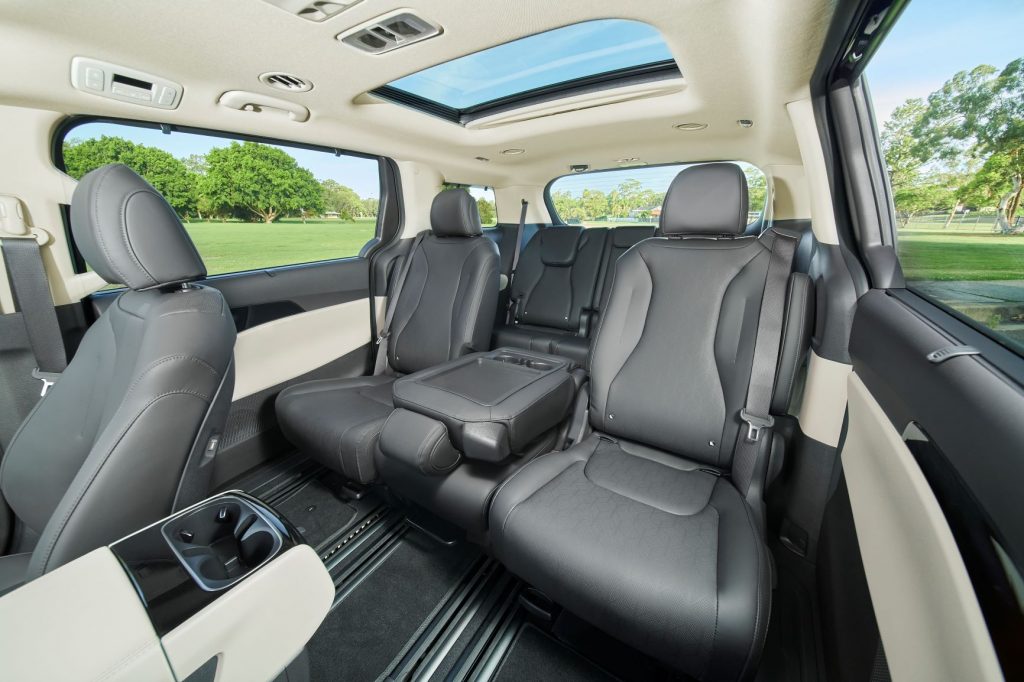
Eight passengers in comfort
Of course, a people mover needs to be able to move groups of people and the Carnival meets this objective with ease.
Eight people are accommodated with more stretch-out room thanks to a 30mm longer wheelbase and 10mm wider body.
Overall dimensions have increased by 40mm to 5155mm.
Luggage space is a best-in-class 2785 litres with the second and third third rows folded down, and 627 litres when they’re upright.
Lift-over height has been reduced by 26mm and the power tailgate and smart power-sliding rear passenger doors make access to cabin and luggage space even easier.
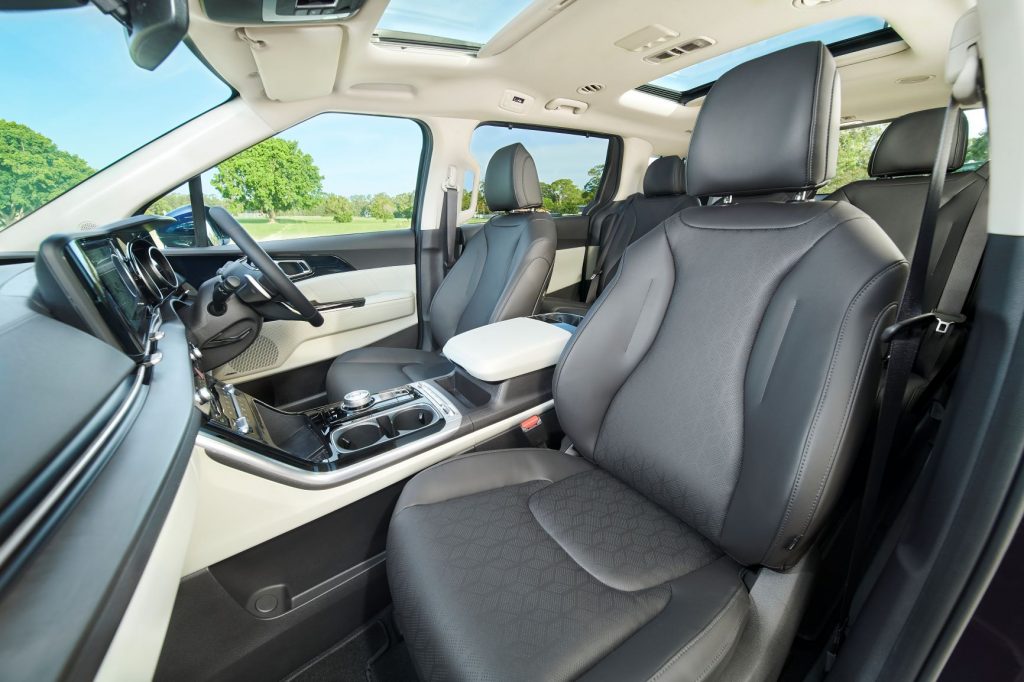 Technology in abundance
Technology in abundance
The user experience of the Carnival is defined by the role of technology and connectivity, with a range of high-tech features designed to make life as easy and convenient as possible. These new technologies assist drivers, while connecting, protecting and entertaining occupants.
The hub of the car’s connectivity features is the high-tech digital display. In Si, SLi and Platinum trims this links Kia’s latest 4.2-inch digital driver instrument cluster and 12.3-inch touchscreen infotainment and navigation system under a single seamless piece of glass. The S level trim has an 8-inch Audio Visual Unit and a 4.2-inch TFT information cluster for the driver.
This screen display creates a panoramic, widescreen user experience, with many infotainment functions controlled via touch-sensitive buttons below the screen. There is a control panel further down the centre console for climate control.
The system offers a crystal-clear display, as well as seamlessly integrated wireless Android Auto and Apple CarPlay (only S variants with the 8-inch Audio Visual unit will be available with wireless connection – this is due to an issue with the third-party supplier insisting Kia use their maps, something Kia has decided it doesn’t wish to do) and voice recognition. The Carnival retains the built-in SatNav with 10 years Mapcare and SUNA live traffic updates.
The infotainment system also enables users to connect two smartphones via Bluetooth at the same time, enabling separate phones to be used for phone calls or media. It will also allow for personalised profiles for various drivers to download individual preferences for AVN and cluster settings.
The ambience in the cabin can also be enhanced by a selection of soothing “Sounds Of Nature” settings playing in the background.
Other technologies are designed to make the Carnival even more practical. These include one-button smart open-and-close for the rear power-sliding doors and tailgate. The smart power-sliding rear doors and tailgate (SLi and Platinum) can also be opened and closed automatically when the key fob is held nearby for three seconds – the perfect measure for parents loading younger passengers into the car.
The Carnival provides Platinum models with puddle lighting which lights up automatically whenever the power sliding door is operated in low light environments, making it safer and easier to get in and out.
The absence of head-up display and auto wipers are notable omissions (partly thanks to Covid). These, and a digital instrument display are likely to appear in the model year 2022 Carnival.
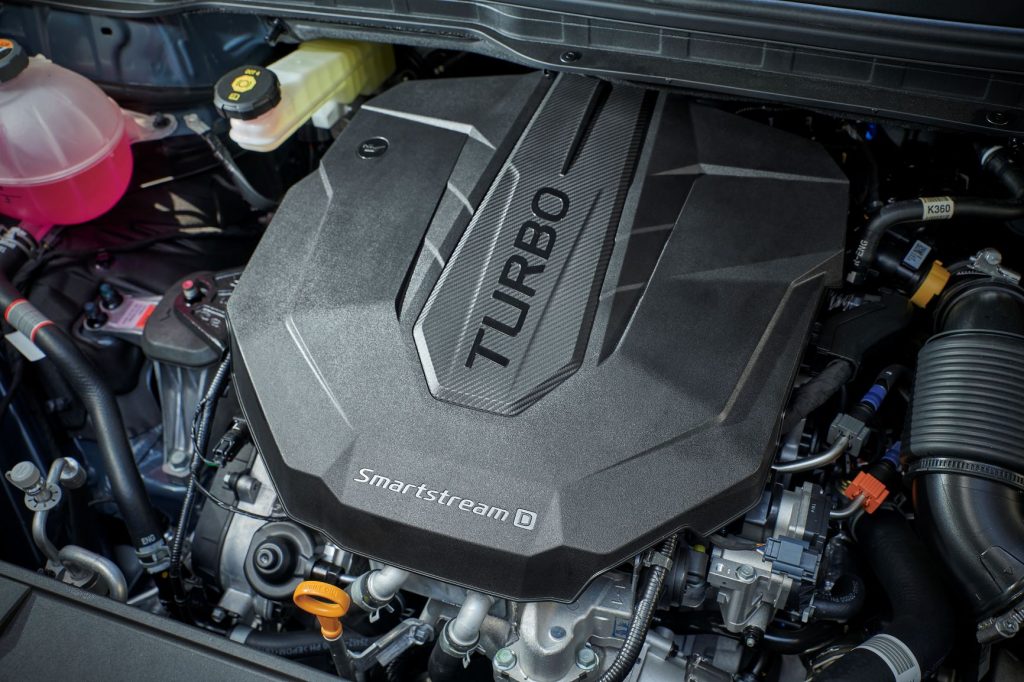
Diesel or petrol power
The most powerful engine in the line-up is a 3.5-litre GDi (gasoline direct injection) V6 producing 216kW and 355Nm torque. This engine features an advanced GDi and multi-point injection (MPI) system, which optimises the combustion cycle depending on conditions to maximise power and efficiency.
A new cooled exhaust gas recirculation system delivers efficiency benefits, helping lower the engine’s combustion temperature for greater fuel economy. A new integrated thermal management and cross-flow system further helps manage the engine’s operating temperature to maximise efficiency at all times, producing a combined cycle consumption of 9.6 l/100km, an improvement of more than 10 percent on the previous engine.
A new 2.2-litre ‘Smartstream’ diesel engine, one of the cleanest diesel units that Kia has ever made, produces 148kW and 440Nm of useable torque over a broad range of engine speeds, the new engine replaces its predecessor’s cast iron block with a lighter aluminium block.
Furthermore, it features a range of measures that reduce friction, aid cooling, enhance efficiency and reduce emissions. These include new high-pressure injectors, new balancer shafts, a thermal management system and selective catalytic reduction to regulate emissions. The end result is a combined cycle fuel consumption reading of 6.5 l/100km, down from 7.6 l/100km in the old engine.
Both engines also produce significantly less CO2 emissions, with the diesel claiming a class leading 170 g/km.
All engines are paired as standard with eight-speed automatic transmissions, offering smooth and swift progress to match the car’s unruffled dynamic character. Kia suggests this transmission will be good for more than 300,000km.
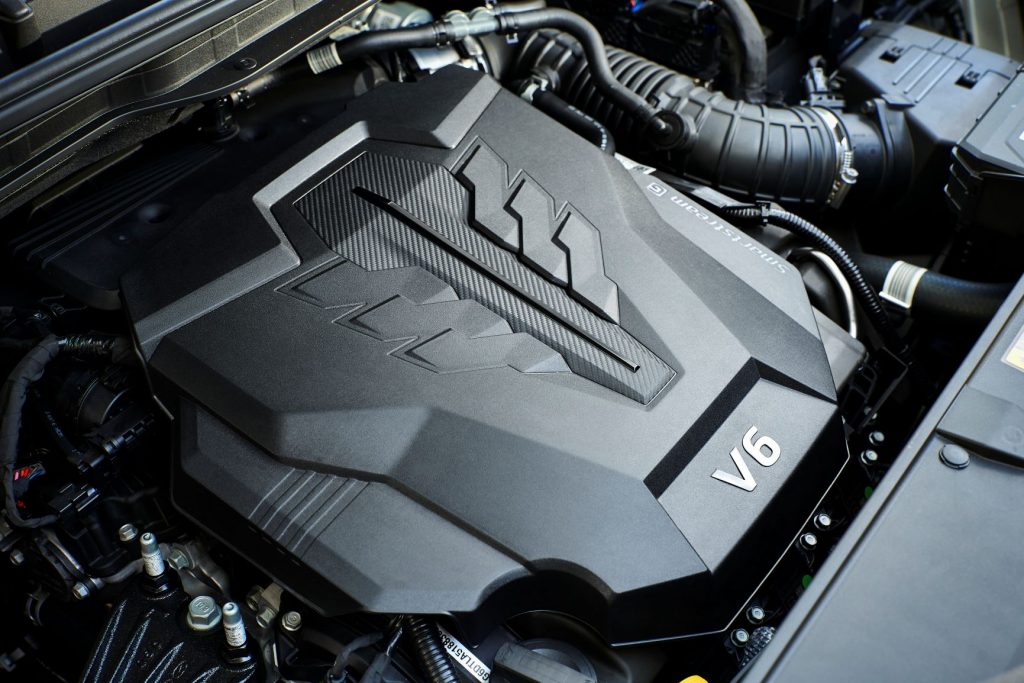
Covid puts the kybosh on local suspension tuning
One of the results of the Covid pandemic has to make it impossible for Kia Australia to carry out its usual local suspension tuning. According to Roland Rivero (general manager, production planning) this won’t be an issue because the Korean-spec suspension has proved to be highly suitable.
However, once it can be carried out, local tuning will be conducted, so changes will be applied to Carnivals on a rolling basis. Unfortunately, early buyers will probably not be able to retro-fit the locally adapted suspension. The same applies to the Korean-spec power steering.
The new fully independent suspension system and a range of noise, vibration and harshness (NVH) measures are engineered to deliver reassuring and relaxing on-road behaviour, maximising stability and occupant comfort.
The suspension system has been dramatically altered compared to the outgoing third-generation Carnival. At the front, Kia’s engineers have applied a new multi-skeletal cross-member and new geometry, better distributing lateral loads on the front suspension from cornering to stabilise handling. The body is also mounted to the rear section of the cross member with new hydro bushes, with liquid inside the rubber bushes reducing the level of suspension and engine vibrations transmitted to the body. This also mitigates the effect of sharp impacts on the front suspension, subtly enhancing ride comfort even over broken surfaces.
The rear suspension has also been revised, with longer lower suspension arms and revised spring layout working to better manage changes in the road surface. Meanwhile the angle of the rear shock absorbers has been adjusted to better absorb shocks from the road.
A new column-mounted motor-driven power steering set-up replaces the outgoing model’s hydraulic power steering system, resulting in a slightly more direct response to steering inputs, with a 5.6 per cent quicker steering ratio. The new system also enables many of the Carnival’s new driver-assist technologies, which rely on an electric power steering motor.
A comprehensive array of sound-deadening and insulating measures ensure the new model is one of the quietest and most refined on the road. These include new insulation materials around all four wheel-arches, a full underbody cover to reduce wind and road noise, and dense insulation between the engine bay and passenger compartment.
The air intake has also been reshaped to reduce engine noise at high speeds, while new crossmembers in the floor of the cabin reduce vibration noise through the body.
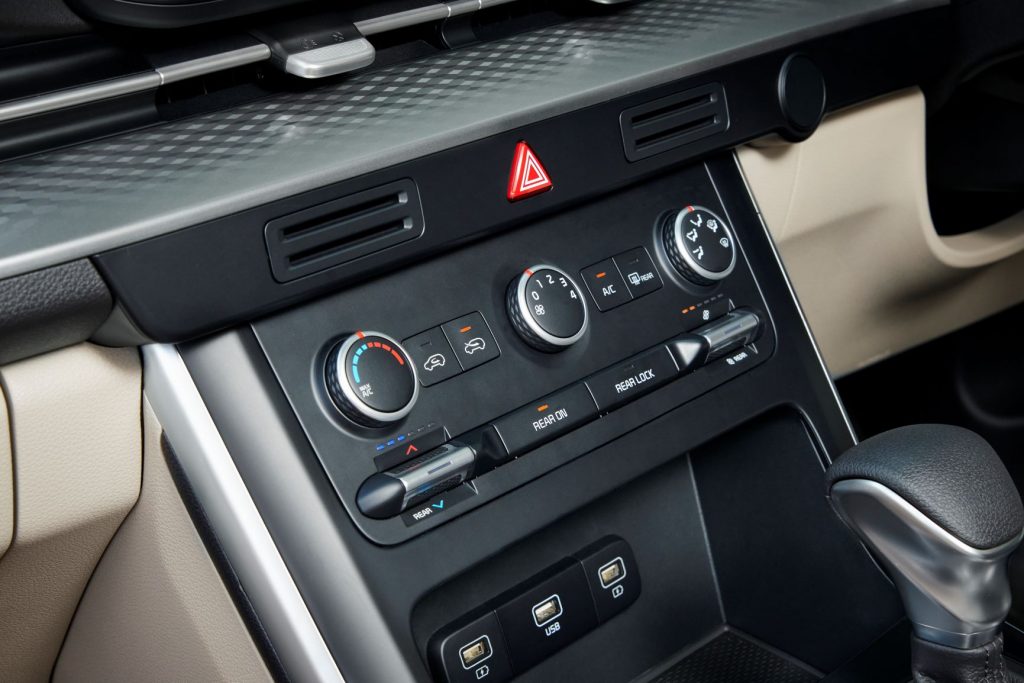
A full suite of safety, as you’d expect in an MPV
Kia’s advanced driver assistance systems (ADAS) help to reduce many of the inherent hazards and stresses of driving.
For Australian drivers, Kia has prioritised safety across the range with a range of segment first and class leading technologies lifting the safety bar from the entry-level S grade right through to Platinum models.
Topping the new technology is the Speed Limit Information Function which reads and displays road-side speed signs and displays that speed on the information cluster. It is supplemented by Intelligent Speed Assist which will use the speed information to alert the driver to a change in speed limit and then alerts the driver to adjust the speed limiter and smart cruise control accordingly.
Additional first in class technology includes Multi Collision Braking, AEB Junction Assist for warnings and automatic braking when turning across traffic if a collision is detected, Driver Attention Warning, Safe Exit Alert (SLi and Platinum) and Rear Cross Traffic Collision Avoidance Assist (SLi and Platinum).
The full ADAS range in the new Carnival is one of the most comprehensive found on any new car today. Available technologies include full-function AEB with car, pedestrian and cyclist detection; Lane Keeping Assist (LKA); Blind-Spot Collision-Avoidance Assist (BCA); Intelligent Speed Limit Assist (ISLA); Driver Attention Warning+ (DAW+ with Leading Vehicle Departure Alert); High Beam Assist (HBA); Smart Cruise Control (SCC); Lane Following Assist (LFA); and Surround View Monitor (SVM on SLi and Platinum).
Safe Exit Assist (SEA) is an important new addition to the suite of safety technologies. SEA, available on SLi and Platinum, prevents the power-sliding rear doors from opening – and young passengers exiting the vehicle – if the system detects a car approaching from behind on either side.
Kia’s “Level 2” autonomous driving technology, Smart Cruise Control, controls acceleration and braking depending on the vehicles in front. Using front view camera and front radar, it helps maintain a set distance and speed from the vehicle ahead while Lane Follow Assist helps centre the vehicle in its lane while driving. In addition, it features a Rear View Monitor (RVM) and Rear Cross-Traffic Collision-Avoidance Assist (RCCA).
The RCCA system helps to avoid collisions with vehicles crossing behind from the left and right sides of the Carnival while reversing. This assists the driver by braking the car automatically if it detects an obstacle crossing behind it.
The new Carnival is also offered with Kia’s innovative Multi-Collision Brake system, which enables the car to mitigate the severity of secondary collisions. It automatically applies the vehicle’s brakes when the airbags have been deployed after an initial collision, further protecting occupants from secondary frontal or side impacts.
The Carnival is fitted with seven airbags, as well as a suite of electronic vehicle safety systems. All models are equipped as standard with Kia’s Vehicle Stability Management (VSM) and Electronic Stability Control, helping drivers maintain control under braking and cornering.
One issue here is that there is no front centre airbag, and this may impact on the Carnival’s ANCAP safety rating. The absence of a central airbag would normally mean a four-star rating, but the Land Rover Defender, which also misses out on a central front airbag, was recently given five ANCAP stars, so we’ll have to wait and see.
The bodyshell comprises different grades of high-strength steel, maximizing torsional rigidity while keeping body weight low. The shell of the new model features newly reinforced pillars, and features a higher proportion of Advanced High-Strength Steel and hot-stamped steel than its predecessor, increasing torsional rigidity and adding strength. The more rigid bodyshell reduces road vibrations and enhances occupant safety in the event of a collision.
Seven years of worry-free motoring
Like all Kia models sold in Australia, the Carnival will be covered by a seven-year warranty, with capped price servicing. The recent announcement of a ten-year warranty by Mitsubishi is unlikely to result in a matching Kia warranty – as COO Damien Meredith points out, the Kia warranty is free of caveats, unlike the Mitsubishi warranty that requires owners to have their vehicles serviced at authorised Mitsubishi dealers. As the initiator of Australia’s longest warranty, though, we’re fairly sure Kia will be considering its options.
Pricing
| RRP | Driveaway Price | |
| S Petrol Auto | $46,880 | $50,390 |
| Si Petrol Auto | $52,380 | $55,790 |
| SLi Petrol Auto | $56,880 | $60,290 |
| Platinum Petrol Auto | $64,680 | $67,990 |
| S Diesel Auto | $48,880 | $52,390 |
| Si Diesel Auto | $54,380 | $57,790 |
| SLi Diesel Auto | $58,880 | $62,290 |
| Platinum Diesel Auto | $66,680 | $69,990 |
Premium Paint is an additional $695.
Once we have tested and assessed the new Kia Carnival, seniordriveraus will bring you a comprehensive review, including everything the over-50 driver needs to know.
